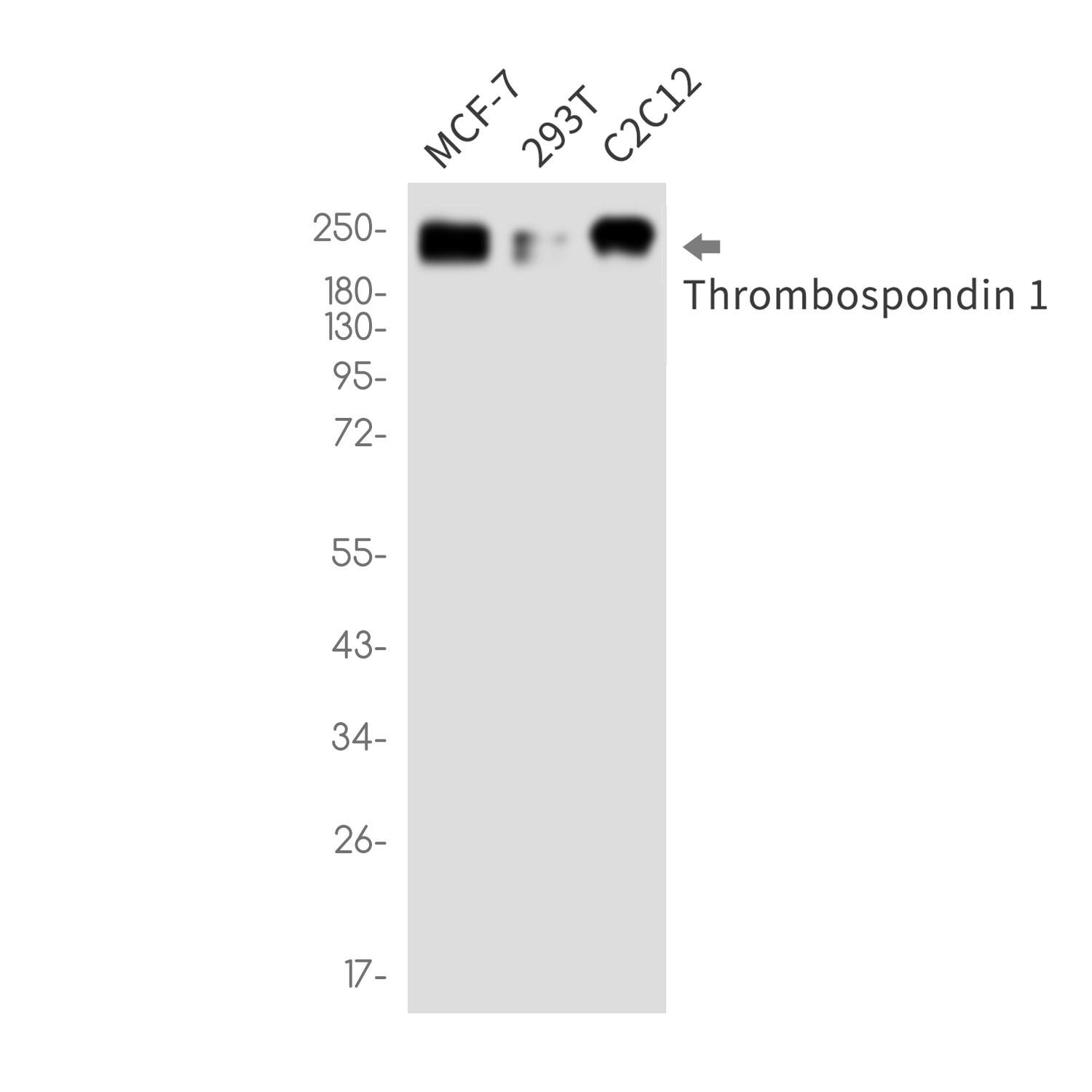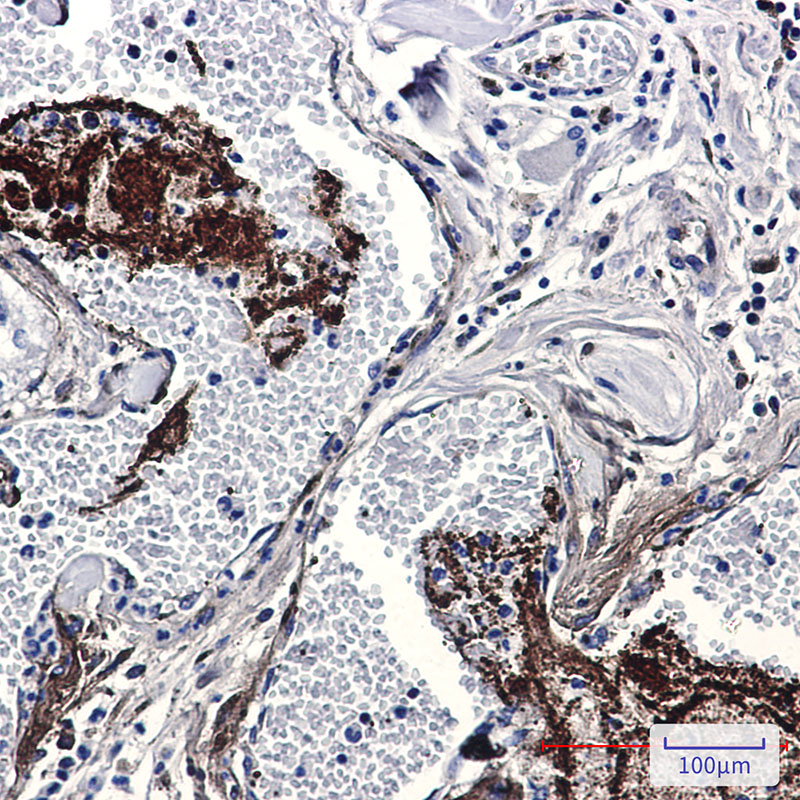Thrombospondin 1 Rabbit mAb
- SPECIFICATION
- CITATIONS
- PROTOCOLS
- BACKGROUND

Application
| WB, IHC-P, IP |
|---|---|
| Primary Accession | P07996 |
| Reactivity | Human, Mouse |
| Host | Rabbit |
| Clonality | Monoclonal Antibody |
| Calculated MW | 129383 Da |
| Gene ID | 7057 |
|---|---|
| Other Names | THBS1 |
| Dilution | WB~~1/500-1/1000 IHC~~1/50-1/100 |
| Format | Liquid |
| Name | THBS1 (HGNC:11785) |
|---|---|
| Synonyms | TSP, TSP1 |
| Function | Adhesive glycoprotein that mediates cell-to-cell and cell-to- matrix interactions (PubMed:15014436, PubMed:18285447, PubMed:2430973, PubMed:6489349). Multifunctional, involved in inflammation, angiogenesis, wound healing, reactive oxygen species (ROS) signaling, nitrous oxide (NO) signaling, apoptosis, senescence, aging, cellular self-renewal, stemness, and cardiovascular and metabolic homeostasis (PubMed:10613822, PubMed:11134179, PubMed:1371676, PubMed:14568985, PubMed:24511121, PubMed:29042481, PubMed:32679764). Negatively modulates dendritic cell activation and cytokine release, as part of an autocrine feedback loop, contributing to the resolution of inflammation and immune homeostasis (PubMed:14568985). Ligand for receptor CD47 (PubMed:19004835, PubMed:8550562). Modulates nitrous oxide (NO) signaling via CD47, hence playing a role as a pressor agent, supporting blood pressure (By similarity). Plays a role in endothelial cell senescence, acting via CD47, by increasing the abundance and activation of NADPH oxidase NOX1, and so generating excess ROS (PubMed:29042481). Inhibits stem cell self-renewal, acting via CD47 signaling, probably by regulation of the stem cell transcription factors POU5F1/OCT4, SOX2, MYC/c-Myc and KLF4 (By similarity). Negatively modulates wound healing, acting via CD47 (By similarity). Ligand for receptor CD36 (PubMed:10613822, PubMed:11134179, PubMed:1371676). Involved in inducing apoptosis in podocytes in response to elevated free fatty acids, acting via CD36 (By similarity). Plays a role in suppressing angiogenesis, acting, depending on context, via CD36 or CD47 (PubMed:10613822, PubMed:11134179, PubMed:1371676, PubMed:32679764). Promotes cellular senescence in a TP53-CDKN1A-RB1 signaling-dependent manner (PubMed:29042481). Ligand for immunoglobulin-like cell surface receptor SIRPA (PubMed:24511121). Involved in ROS signaling in non- phagocytic cells, stimulating NADPH oxidase-derived ROS production, acting via interaction with SIRPA (PubMed:24511121). Plays a role in metabolic dysfunction in diet-induced obesity, perhaps acting by exacerbating adipose inflammatory activity; its effects may be mediated, at least in part, through enhanced adipocyte proliferation (By similarity). Plays a role in ER stress response, via its interaction with the activating transcription factor 6 alpha (ATF6) which produces adaptive ER stress response factors (By similarity). May be involved in age-related conditions, including metabolic dysregulation, during normal aging (PubMed:29042481, PubMed:32679764). |
| Cellular Location | Secreted. Cell surface. Secreted, extracellular space, extracellular matrix. Endoplasmic reticulum {ECO:0000250|UniProtKB:P35441}. Sarcoplasmic reticulum {ECO:0000250|UniProtKB:P35441}. Note=Secreted by thrombin-activated platelets and binds to the cell surface in the presence of extracellular Ca(2+) (PubMed:101549, PubMed:6777381). Incorporated into the extracellular matrix (ECM) of fibroblasts (PubMed:6341993). The C- terminal region in trimeric form is required for retention in the ECM (PubMed:18285447). Also detected in the endoplasmic reticulum and sarcoplasmic reticulum where it plays a role in the ER stress response (By similarity). {ECO:0000250|UniProtKB:P35441, ECO:0000269|PubMed:6341993, ECO:0000269|PubMed:6777381} |
| Tissue Location | Expressed by platelets (at protein level) (PubMed:101549). Expressed by monocyte-derived immature and mature dendritic cells (at protein level) (PubMed:14568985) |

Thousands of laboratories across the world have published research that depended on the performance of antibodies from Abcepta to advance their research. Check out links to articles that cite our products in major peer-reviewed journals, organized by research category.
info@abcepta.com, and receive a free "I Love Antibodies" mug.
Provided below are standard protocols that you may find useful for product applications.
If you have used an Abcepta product and would like to share how it has performed, please click on the "Submit Review" button and provide the requested information. Our staff will examine and post your review and contact you if needed.
If you have any additional inquiries please email technical services at tech@abcepta.com.













 Foundational characteristics of cancer include proliferation, angiogenesis, migration, evasion of apoptosis, and cellular immortality. Find key markers for these cellular processes and antibodies to detect them.
Foundational characteristics of cancer include proliferation, angiogenesis, migration, evasion of apoptosis, and cellular immortality. Find key markers for these cellular processes and antibodies to detect them. The SUMOplot™ Analysis Program predicts and scores sumoylation sites in your protein. SUMOylation is a post-translational modification involved in various cellular processes, such as nuclear-cytosolic transport, transcriptional regulation, apoptosis, protein stability, response to stress, and progression through the cell cycle.
The SUMOplot™ Analysis Program predicts and scores sumoylation sites in your protein. SUMOylation is a post-translational modification involved in various cellular processes, such as nuclear-cytosolic transport, transcriptional regulation, apoptosis, protein stability, response to stress, and progression through the cell cycle. The Autophagy Receptor Motif Plotter predicts and scores autophagy receptor binding sites in your protein. Identifying proteins connected to this pathway is critical to understanding the role of autophagy in physiological as well as pathological processes such as development, differentiation, neurodegenerative diseases, stress, infection, and cancer.
The Autophagy Receptor Motif Plotter predicts and scores autophagy receptor binding sites in your protein. Identifying proteins connected to this pathway is critical to understanding the role of autophagy in physiological as well as pathological processes such as development, differentiation, neurodegenerative diseases, stress, infection, and cancer.



